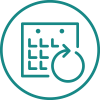
Haematinics

Haematinics
Purpose:
The Haematinic panel of tests are often undertaken on routine Immunoassay and spectrophotometric platforms used by Medical Biochemistry Departments and are no longer confined to specialist Haematology Departments. This Programme covers the main parameters assayed by Biochemistry Departments.
Ferritin is used as an indicator of iron status. A ferritin of <30ug/L is indicative of iron deficiency, whilst an elevated level (>400 ug/L) is indicative of iron overloading such as haemosiderosis or haemochromatosis. Elevated ferritin values are also encountered in certain tumours: acute leukaemia, Hodgkins disease and carcinoma of the lung, colon, liver and prostate.
Investigation of folate deficiency may be indicated when nutritional, macrocytic or megaloblastic anaemias are suspected. Since a deficiency of either vitamin B12 or folate can cause megaloblastic anaemia, both tests are indicated in order to diagnose the aetiology of anaemia.
There is currently no standard test for measuring vitamin B12 deficiency.
- Use either total B12 (serum cobalamin) or active B12 (serum holotranscobalamin) as the initial test for suspected vitamin B12 deficiency unless: the test needs to be done during pregnancy, or recreational nitrous oxide use is the suspected cause of deficiency.
- Use active B12 as the initial test for suspected vitamin B12 deficiency during pregnancy.
- If the person has suspected vitamin B12 deficiency caused by recreational use of nitrous oxide:
use plasma homocysteine or serum methylmalonic acid (MMA) as the initial test and if using plasma homocysteine, refer the person to phlebotomy services in secondary care for this test. - Take blood samples for diagnostic tests before starting vitamin B12 replacement.
- When offering an initial diagnostic test, ask the person if they are already using an over-the-counter preparation that contains vitamin B12 (including vitamin B12 tablets, injections or transdermal patches), and what type and dosage they are using. See the section on factors that can affect total or active B12 test results.
Interpreting total or active B12 test results
| Results if testing total B12 | Results if testing active B12 | Likelihood of vitamin B12 deficiency |
|---|---|---|
| <180 ng/L , (133 pmol/L) | < 25 pmol /L | Confirmed vitamin B12 deficiency |
| 180 to 350 ng/L , (133 – 258 pmol/L) | 25 to 70 pmol/L | Indeterminate test result – possible vitamin B12 deficiency |
| > 350 ng/L, (258 pmol/L) | > 70 pmol/L | Test result suggests vitamin B12 deficiency is unlikely |
NICE Medtech innovation briefing 40, Active B12 assay for diagnosing Vitamin B12 deficiency.
Iron (non-haem) measurements are used in the diagnosis and treatment of diseases such as iron deficiency anaemia, haemochromatosis and chronic renal disease and in the diagnosis of acute iron toxicity.
Total iron-binding capacity (TIBC) is a measurement of the maximum iron concentration that transferrin can bind. In iron-deficiency anaemia the TIBC is elevated and the transferrin saturation is lowered to 15 % or less. Low serum iron associated with low TIBC is characteristic of the anaemia of chronic disorders, malignant tumours, and infections.
Scope:
Four liquid human serum samples are distributed monthly, with a minimum of 48 samples distributed over the year covering a wide clinically relevant range. The material is prepared from endogenous samples donated by polycythaemic, hemochromatosis, renal patients and healthy volunteers. The samples consist of a panel of 10 samples distributed on a number of occasions over that period which are used to assess both laboratory and method performance, including linearity, bias, within and between batch imprecision. Additional challenging samples spiked with iron traceable to NIST SRM #928 are distributed to assess the performance at mild and severely toxic levels.
Calculated parameters are also assessed such as TIBC and Transferrin Saturation. A separate programme is available for Homocysteine.
 |
Key Features:
|
| Haematinics Programme | ||
|---|---|---|
| Analyte | Approx. Range Covered | |
| Ferritin | 5 - 3500 | µg/L |
| B12 | 120 - 850 | ng/L |
| Active B12 | 0 - 300 | pmol/L |
| Folate | 1.2 - 24 | µg/L |
| Iron | 4 - 160 | µmol/L |
| TIBC | 27 - 90 | µmol/L |
| UIBC | 3 - 100 | µmol/L |
| Transferrin | 1.6 - 4 | g/L |
| Transferrin Saturation | 10 - 90 | % |
Related Documents
Last updated: 18/09/2025








